Sunnylands Center and Gardens, Palm Springs, CA
In virtually every respect, Sunnylands Center and Gardens is the polar opposite of family-run Moorten Botanical Garden. The two things they have in common—both are located in the Palm Springs area and both showcase desert plants—are eclipsed by their differences. Moorten is 1 acre in size, Sunnylands 200; Moorten looks to be run on a shoestring budget, Sunnylands is flush with money; Moorten is visited by normal folks like you and me; Sunnylands is a “high-level retreat center” for the likes of President Obama.
And yet, both places are outstanding destinations for succulents lovers. Moorten very much looks like a private garden—which it once was and, and its heart, it still is—while Sunnylands showcases landscape design on a grand scale and scope. Where else can you see many hundreds (maybe even thousands) of golden barrel cactus (Echinocactus grusonii) all lined up like soldiers at a parade?
Only 70 species of desert or desert-adapted plants are used in the 15-acre garden in front of and behind the newly built 15,000 sq. ft. visitor center, but to achieve the desired color and texture effects, over 53,000 individual plants were installed. The plant procurement process took an entire year and involved five nurseries in California and Arizona. The details of such a large-scale project are fascinating; the articles listed under “Further reading” at the bottom of this post make for riveting reading.
I won’t go into the history of Sunnylands and billionaires Walter and Leonore Annenberg who owned the property before they converted it to a non-profit foundation; this Wikipedia article has all the basics in case you’re interested. What is important to remember is that landscape architect James Burnett was inspired by the Annenberg’s love of Impressionist painting and arranged the plants like an “Impressionist canvas.”
The video above is an unedited slideshow of all the photos I took at Sunnylands. I thought I’d offer this an option in addition to the selection of edited and processed photos below. Be sure to view the video at the highest resolution for the crispest image quality.
Let’s start at the entrance to the property, which is located on Bob Hope Drive in the town of Rancho Mirage, a few miles southeast of Palm Springs proper. The plantings at the entrance and along Entry Drive, which leads to the parking lot adjacent to the visitor center, set the tone for what’s to come. My jaw dropped when I saw the masses of golden barrel cactus (Echinocactus grusonii). There was no place to pull over, so I walked back to the entrance from the parking lot to take these photos.
According to landscape architect James Burnett, Agave desmettiana was his agave of choice because of its deep green color. Many of them were blooming right at the entrance, as well as outside the visitor center (see photos further down).
13 agave species are used in the mass plantings, including Agave ‘Sharkskin’ seen in the next photo:
The plant palette comprises only five varieties of trees: sweet acacia (Acacia farnesiana), texas ebony (Ebenopsis ebano), palo brea (Parkinsonia praceox), ‘Desert Museum’ palo verde (Parkinsonia ‘Desert Museum’), and several varieties of mesquite (Prosopsis sp.). The mesquite along the Botanic Walk to the left of the entrance drive are lovely. I wish I had room in my own garden for one of the thornless hybrids now available.
This golden barrel pattern is particularly stunning:
Other sections of the Botanic Walk along Entry Drive reminded me of the growing grounds of a large nursery, albeit perfectly neat and controlled. In fact the project narrative submitted by the Office of James Burnett for the 2012 American Society of Landscape Architects Professional Awards specifically mentions this design goal: “Plantings were designed ‘in mass’ much like one experiences a large nursery.”
Yucca rostrata galore:
Golden barrel cactus in front of steely blue agaves: what a contrast!
More photos from the Botanic Walk along Entry Drive:
Entry Drive ends at the visitor center. The covered walkway you see below, flanked by bloomed Agave desmettiana, leads from the parking lot to the visitor center.
Right in front of the visitor center is the Entry Court planted with golden barrel cactus and Agave desmettiana and top-dressed with black decomposed granite for contrast.
The effect is stunning against the mid-century modern façade of the visitor center.
I only took one photo inside the visitor center, but I hope it will give you an idea of how sleek and upscale it is. The restrooms were the nicest public restrooms I’ve seen in my life—ultra high-quality materials throughout.
The wall on the right isn’t a quilt, as you might first think, but natural stone
After walking through the visitor center you arrive at what I consider the “crown jewel” of the Sunnylands gardens: the terrace with two reflecting pools and specimen gardens at either side.
While the use of water features in a climate that, on average, gets less than 5 inches of rain a year may seem frivolous to some, I think these reflecting pools are fantastic. They actually emphasize how precious water is in the desert and provide a meaningful contrast against the desert plantings beyond. In addition, the reflections of the ‘Desert Museum’ palo verde and the desert sky—amended by the texture of the large pebbles at the bottom of the pools—create a touch of Impressionism that the Annenbergs would have appreciated (Walter died in 2002 and Leonore in 2009 and never saw these gardens).
As I mentioned above, each reflecting pool terminates in a specimen garden featuring particularly remarkable succulents. Top dressing of black granite unifies the design.
The planting scheme parallel to the reflecting pools is very simple: golden barrel cactus and ‘Desert Museum’ palo verde. The golden barrels are arranged in a perfect grid, like soldiers standing at attention during a parade.
There are subtle queues that the “real” Sunnylands—the original Annenberg estate that you can’t even see from the visitor center and gardens—is in high demand for diplomatic purposes. Take a look at this plaque. President Obama met with Chinese President Xi Jiping at Sunnylands in June 2013.
The visitor center includes a small gift shop and a café where I had lunch. The food was exquisite—I shouldn’t have been surprised. It was a bit too cool to sit outside, but look at the view!
After lunch I explored the plantings beyond the café (and visitor center). A series of smaller-scale private gardens with benches invite contemplation. The plantings are rich and varied, but always formal and geometric.
Aloe ‘Blue Elf’
Aloe ‘Blue Elf’
Agave parryi
Agave parryi
Agave parryi
Agave parryi, Echinocactus grusonii, and Fouquieria splendens
Agave parryi, Echinocactus grusonii, and Fouquieria splendens
Agave parryi
View of the Performance Circle
Aloes along the Botanic Walk on the far side of the Great Lawn
Aloes along the Botanic Walk on the far side of the Great Lawn
More views of the “nursery growing grounds” aesthetic
More views of the “nursery growing grounds” aesthetic
Agave titanota
Euphorbia resinifera
Agave tequilana
Agave parryi
I understand that some people might not like Sunnylands because the design is so formal, controlled, and regimented. I, however, was in love—I’m sure you can tell by the number of photos I took. Wherever I turned, there was another vista I wanted to photograph. I’d never seen anything like it. In fact, I doubt there is anything like it anywhere in the word. The next time I’m in Palm Springs, Sunnylands will be the first place I visit. (That, and the best vegan restaurant in the universe, Native Foods Café.)
FURTHER READING:
- Sunnylands Center & Gardens (Office of James Burnett, the landscape architect behind the garden design); beautiful high-resolution photographs and a video documenting the progress of the project (including stunning time-lapse photography of the installation of the garden)
- Sunnylands Center & Gardens (2012 American Society of Landscape Architects Professional Awards); excellent summary of the landscape design; includes a high-resolution site plan
- The Artful Garden (Palm Springs Life)
RELATED POST:







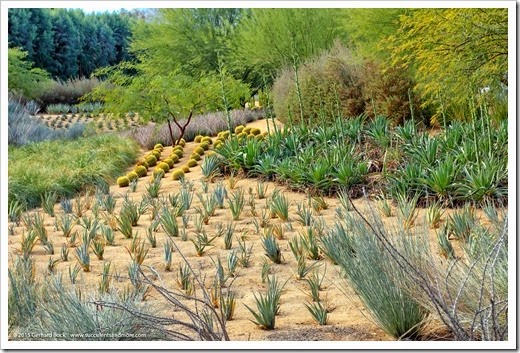





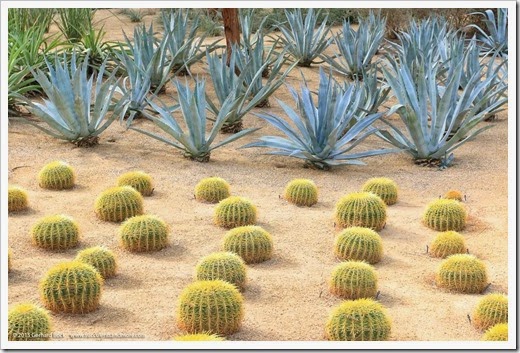






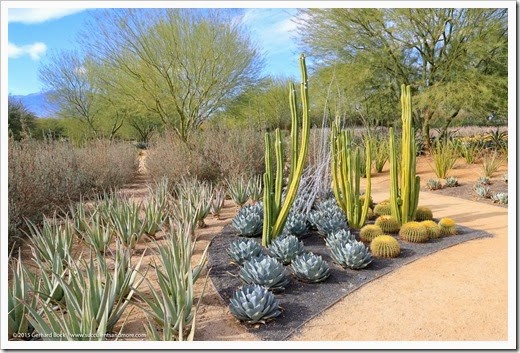

















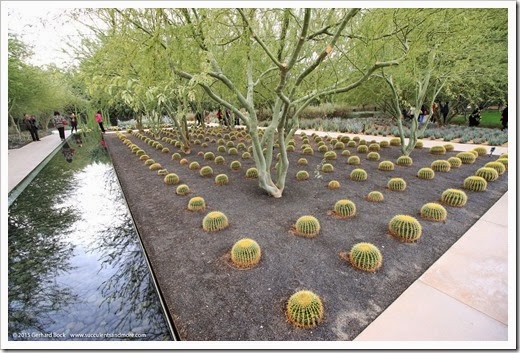



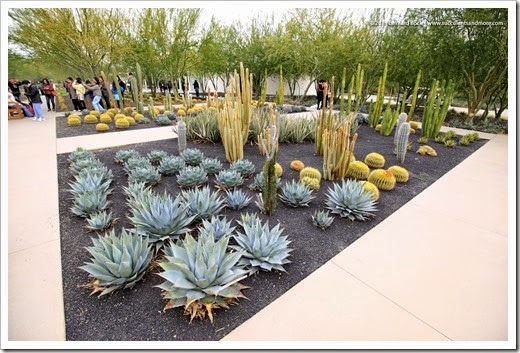
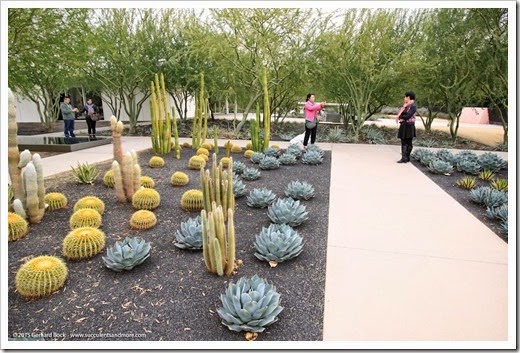
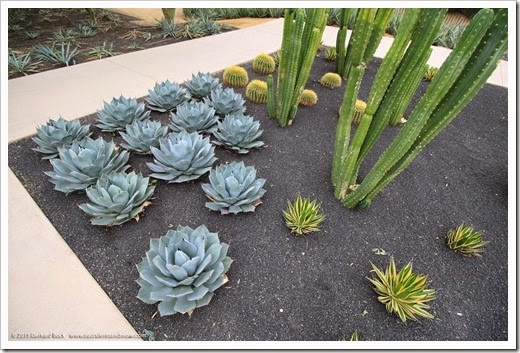
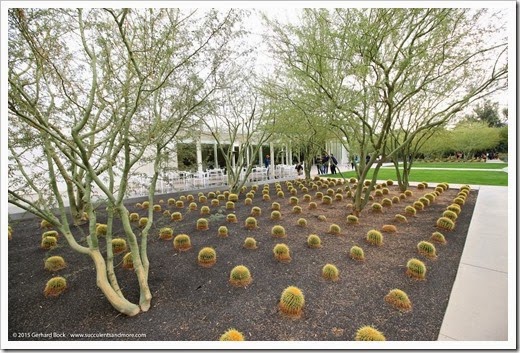









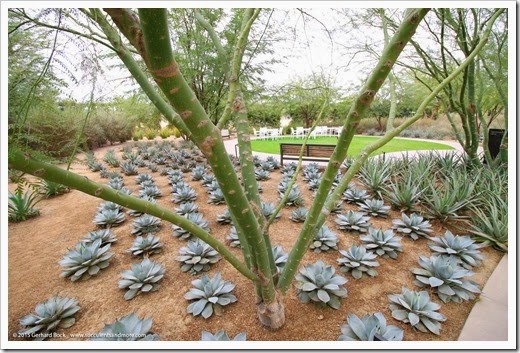
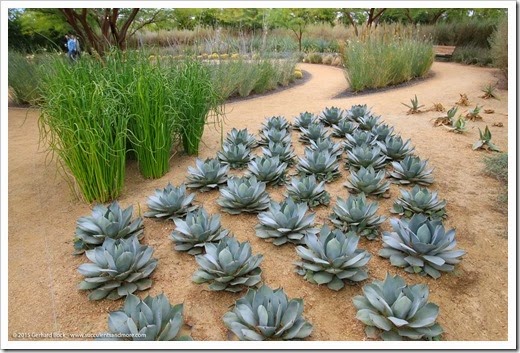
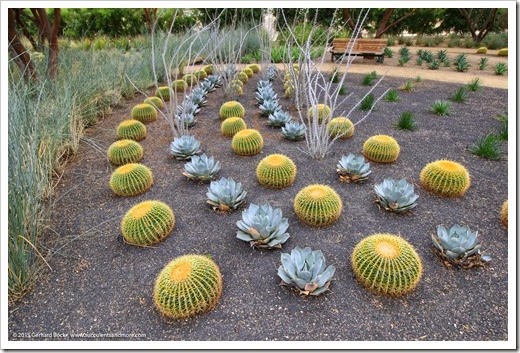







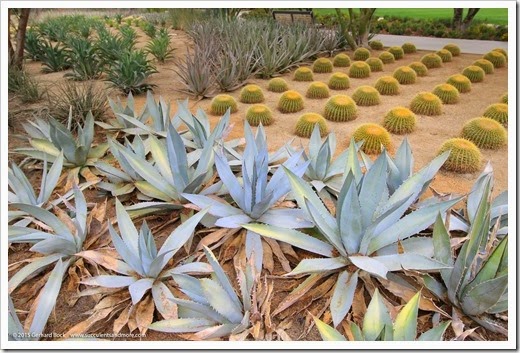

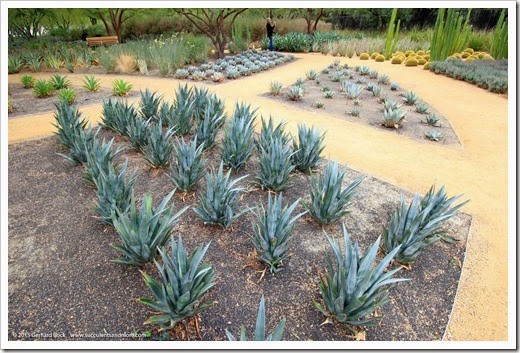

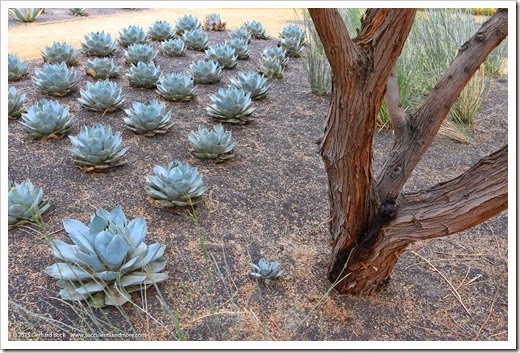
I love the formality also, though I think some of the Agave groups are planted too close together ( for example, titanota) and I'm not sure the black dg is quite right. If only I were not such a plant nut, that would be my style of garden...
ReplyDeleteOut of all the plants they've chosen for Sunnylands, Agave titanota was my least favorite. Usually it's a species I really like, but I don't think it looked all that great where they were using it. But other than that, there was little I didn't like. Of course the big question in my mind is how this garden will age.
DeleteI suspect they have the $$ to update it whenever necessary!
DeleteI adore a bold geometric design so this is just wonderful to my eye. As for the reflecting pools I think they are a great use of a limited resource, it gives the feeling of a wealth of water while being basically a minimal usage. Great photos Gerhard!
ReplyDeleteDo check out Sunnylands if you ever find yourself in Palm Springs. I'd love to read your take on it.
DeleteThe reflective pool looks great, not ostentatious but complements the rest of the design and planting well. Very bold use of succulents, in large swathes and lines, it grew on me!
ReplyDeleteIn my eyes, the reflecting pools are contemporary and make a statement without screaming "look at me, I'm so cool." I loved them.
DeleteI so always look forward to your blogs Gerhard. I love the simplicity and formal design. Mass plantings make a lit of sense for a big area like this. Now you are making me want to go to Palm Springs.
ReplyDelete"Simplicity" is a good word. Simple, yet bold and confident. I'm thinking I need to spend more time in Palm Strings. I bet there are many more treasures waiting to be explored.
DeleteI, too, love this garden and I thank you for the extensive coverage. It shows that climate-adapted and/or native plants don't have to be in a naturalistic setting, but can be used as in a formal garden. I've not seen this elsewhere. The other fabulous point about this garden is that it demonstrates to the Palm Springs/Palm Desert residents that beautiful, appealing gardens need not use large amounts of water. When I worked for CA Dept of Water Resources, this area had the highest water usage in the entire state in order to keep their vast lawns and golf courses green. Places like this are changing that aesthetic.
ReplyDeleteI hadn't been to Palm Springs since 2011 and I noticed a big change just driving around. There's definitely less lawn now than four years ago. The drought seems to have caused people to rethink their landscaping choices. It was good to see this development. Now if we could only get the large resorts and golf courses to come on board...
DeleteNow I understand why barrel cactus are so expensive! Sunnylands locked up all the available plants. The garden is impressive to say the least but I admit that the formality of it is off-putting to me. It reminds me a bit of the succulent garden surrounding the new Newport Beach civic center (featured last year in a couple of posts by Hoover Boo). As the plants mature, pup, and die, I wonder if Sunnylands will allow the garden to assume a more natural pattern or work to preserve the current formal structure?
ReplyDeleteYou brought up a question that was on my mind as well: How will the gardens at Sunnylands age? The agaves will die after they flower and the geometric lines will be destroyed. But clearly this is something the folks responsible for the design and plant selection were aware of and must have planned for.
DeleteThe flowering Agave desmettiana aren't an issue because they're not planted in strictly geometric patterns and they'll leave behind plenty of pups. In fact, I'm sure Agave desmettiana was selected precisely because it flowers at an early age (5-7 years). The sight of so many flowering Agave desmettiana made my jaw drop, it was that beautiful.
My original design for our front garden was basically this, but with plants that would grow here. Very geometric, multiples in a line, everything spaced just so. I LOVED the concept but the reality was very hard to keep up.
DeleteI can only imagine! Of course, unlike Sunnylands, you didn't have landscapers to do the work :-).
DeletePerhaps it has more impact in person, but I pretty much hate this. All of the "whitespace" around the plants makes me uncomfortable. I understand the vision and love strong geometric patterns, but its too artificial for my tastes. Sorry!
ReplyDeleteThis kind of landscape design provokes strong reactions. I'm sure you're not the only one who hates it. To me, it's a fantasy, one that only works on a large scale. As such, I bought into it hook, line and sinker.
DeleteThis would make the perfect winter road trip. Last time I was in Palm Springs I skipped Sunnylands, so thanks for this gorgeous reminder to pay it a visit.
ReplyDeleteInitially I wasn't sure if I'd have time to visit Sunnylands since Palm Springs was just a stopover, but I'm so glad I went. I hope you'll get a chance to go for yourself; I'd love to see your photos.
DeleteSome of it looks kind of cool but a little to clinical for me. Feels cold. Weird reaction.
ReplyDeleteAlan had a similar reaction. Yes, it's definitely the opposite of naturalistic. I often don't like things that formal and rigid, but for some unfathomable reason I couldn't get enough of Sunnylands. Go figure.
DeleteThe juxtaposition of barrel cacti, ocotillos and agaves was breathtaking. We were there last year for Modernism Week and had the same reaction you had Gerhard.
Delete